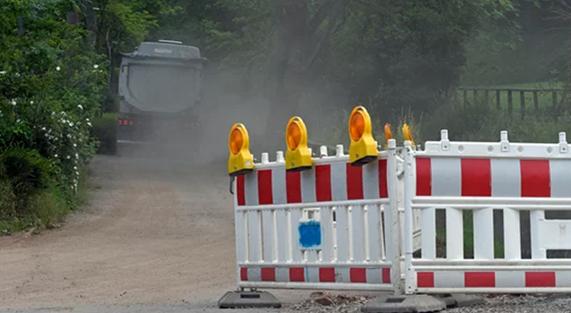Utilising Barricades for Ensuring Safety

Barricade for construction sites
In the swiftly evolving landscape of today’s world, placing health and safety at the forefront assumes paramount importance. This holds particularly true in workplaces throughout the United Kingdom, where employers are resolute in safeguarding their employees. In this context, barricades play an indispensable role – they offer security, facilitate organisation, and ensure safety. It’s important to note that the significance of barricades transcends construction sites, extending to commercial spaces and the domains of builders, contributing to protecting individuals and preventing accidents.
This article delves into the diverse array of barricades and temporary barriers employed in construction while also exploring effective installation and maintenance methods. Moreover, we’ll delve into the key considerations when selecting the appropriate barricades tailored to specific requirements.
The Relevance of Barricades in the UK
Barricades hold exceptional importance on construction sites for a multitude of reasons. Statistics in the UK underscore this significance. For instance, data reveals that the construction sector in the United Kingdom witnessed 61,713 reported injuries under the Reporting of Injuries, Diseases and Dangerous Occurrences Regulations (RIDDOR). This stark reality emphasises the necessity for preemptive measures, with the primary objective being injury prevention. Barricades stand as invaluable allies in achieving this goal, acting as shields to safeguard workers and the public from potential hazards such as moving machinery, unsafe materials, or falling debris. Accidents can be forestalled by having appropriate barriers in place, thereby guaranteeing the safety of all on the site.
Furthermore, the significance of barricades extends beyond injury prevention. It also aligns with legal prerequisites established by the UK’s legislative framework. This framework encompasses regulations by entities like the Health and Safety Executive (HSE), which formulate standards and guidelines that underscore the importance of employing barricades to establish secure work environments.
Additionally, the realm of site security augments the scope of barricade imperatives. Beyond their primary role as custodians of physical safety, barricades also serve as guardians against unauthorised access. They operate as staunch protectors, deterring entry without authorisation and preserving valuable equipment from potential theft. In doing so, they contribute to public safety as well.
Diverse Facets of Barricades in Construction
Within the confines of construction sites, the accent on safety is unyielding. Barricades, as tangible entities, stand as sentinels of safety, ensuring the well-being of both workers and the general populace. An assortment of barricade types caters to distinct needs:
Traffic Barricades
These barricades are ubiquitous in construction areas. Crafted from materials like steel or concrete, they effectively reroute both vehicular and pedestrian traffic. Amidst bustling thoroughfares, these barricades stand resilient, defying impacts and skillfully directing movement.
Temporary Barricades
The construction landscape thrives on adaptability, necessitating swift adjustments. Enter temporary barricades fashioned from lightweight materials such as plastic or wood. Boasting portability, these barriers establish ephemeral boundaries, facilitating rapid and versatile configurations around workspaces while dissuading unauthorised access.
Construction Barricades
Inherent construction hazards demand unwavering vigilance. Barricades forged from wood, steel, or plastic emerge as custodians. Their durability safeguards pedestrians from imminent risks while facilitating temporary pathways.
Road Barricades
The nexus of construction and roads mandates the role of road barricades. Characterised by heightened visibility, these barricades choreograph traffic movement, ensuring safety for drivers and pedestrians near roads or highways.
Optimal Practices for Barricade Excellence
Maximising the utility of barricades necessitates adherence to best practices steeped in industry wisdom and operational acumen:
Precise Installation
The effectiveness of barricades hinges on meticulous installation. Placing them strategically to cordon off hazardous zones and streamline traffic is pivotal. Proper anchoring ensures resilience against weather conditions.
Regular Checks and Maintenance of the barricades
Barricade longevity hinges on consistent assessments and vigilant upkeep. Regular checks to identify signs of wear, such as cracks or loose components, are imperative. Swift rectification of any issues maintains safety standards.
Effective Signage
Barricades, complemented by clear signage, evolve into navigational aids, averting accidents. Signage should be easily comprehensible, conveying potential risks and requisite safety measures. The prominent positioning of construction safety signs ensures visibility for all on-site.
Adherence to Regulations
A thread of compliance is interwoven into the fabric of barricading, aligned with regulatory benchmarks. A labyrinthine array of regulations governs barricade usage, marked by regional nuances. Adhering to these mandates averts legal complications and nurtures a culture of safety.
Choosing the Right Barricades
Selecting the most suitability for construction sites involves a multi-dimensional evaluation:
Barricade Selection
Selecting the right product for the project is very important. For instance, traffic barriers thrive in road projects, while rigid barricades are perfect for vertical construction.
Environmental Context
The surroundings exert discernible influence. Proximity to roads or pedestrian traffic shapes barricade choice. Tailoring barricades to the environment enhances their efficacy.
Financial Considerations
While safety is paramount, financial prudence matters too. They span a range of materials and prices, from cost-effective plastics to robust steel. Striking a balance between safety and budget is crucial.
Barricade Sturdiness and Endurance
They must withstand rigorous conditions, including adverse weather and potential impacts. They should endure vehicular collisions and heavy machinery usage.
They stand as a cornerstone of construction safety. By making informed choices, following best practices, and adhering to safety guidelines and regulations, construction sites can evolve into safer and more efficient environments. Assessing and refining barricading strategies is pivotal in fostering a safer workplace.
Durability and tenacity characterise the essence of barricades. The demanding construction environment necessitates remarkable strength. Unforgiving weather conditions – strong winds, heavy rain, and extreme temperatures – underscore the necessity for products that can endure. Moreover, these barricades must withstand collisions with vehicles and the rigours of heavy machinery usage.






